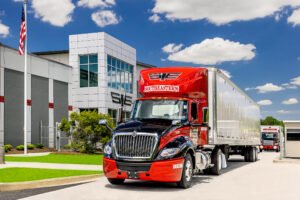Change is seldom an easy endeavor, and when technology is involved, gaining acceptance throughout an organization can be difficult. After all, while computers are good at solving math problems, they don’t always perform well with issues involving people.
In a human-focused industry like trucking, which is increasingly driven by information technology, balancing human interaction and technology is important.
Carriers that inject technology too quickly into processes that have historically been human-driven can look forward to problems — and so can carriers that don’t adopt technology fast enough to keep up with the industry standard.
Data-Driven Solutions
Change management plays a primary role in successfully adopting data-driven solutions.
“There are areas in freight management where we have to inject more technology to become lean, smart, and profitable,” said Chris DeMillo, vice president of information technology for Leonard’s Express. “With our recent Optimal Dynamics implementation, we’re excited to see what the coming months will bring our operations teams in terms of efficiency of velocity decision making and nimble execution strategy.”
DeMillo noted that these changes will cause some disruptions — but they will reveal problems that can be solved with technology. Carriers should prepare for technological changes to ease the transition.
“Any carrier that’s looking to lean into (technology) and level up their service to their customers or their profitability and internal efficiency is not just going to flip a switch,” said Zach Schuchart, head of sales for Optimal Dynamics.
Implementing technology requires that carrier executives take a hard look at processes and identify the bottlenecks and types of decisions that create inefficiencies. Sometimes, fully examining these roadblocks reveals extremely complex issues. Data is the driving force in analyzing and resolving those issues.
“Whether it’s a driver’s personal needs, appointment times or relays, we have to know if we have the necessary data to make decisions” said Jeff Yin, vice president of technology for Motorcity Systems.
Such data helps with evaluation and assessment and shows decision-makers the importance of a top-down commitment to optimization.
“Everybody has to be on the same page,” said Kyle Johnson, CEO of Leonard’s Express. “You can’t operate with notes, whiteboards and tablets. You have to get information into the system, be disciplined about it and create structures leading to better decisions.
“It’s always gonna be a ‘roll up your sleeves and get after it’ endeavor,” he continued.
Plan Ahead
On the front end of implementing significant change using IT, a carrier needs to decide how it will handle systems planning and design.
Some carriers have IT teams that may be able to handle integration of platforms — but once they’re implemented, the programs must be maintained. Chances are that an outside partner would be better at managing future maintenance and tweaking of the system.
“The partner should be the expert with their product, and the carrier team should focus on the data and supplying information,” DeMillo said. “It’s important to say, ‘We’re not going to do this in-house; we’re finding a partner with some very smart people outside our organization to do it for us.’”
Sometimes making such decisions is a long and arduous process. That’s why it’s important to have support for change at every level of the company.
“A big thing is making sure there is buy-in from not only upper management, but also all the way down to the floor,” DeMillo said.
Implementing change requires preparation and simplification of operational structure to accommodate the quickly growing need for technology in the industry.
Managing Change
“Change management is a big concern,” said Yin. “The optimization engine isn’t going to solve a customer service problem or a very advanced solution that you’re trying to deliver to a customer that you’re negotiating with.”
That’s when understanding the capabilities of the systems and when they come into play becomes important.
In planning for change, it must be understood that decision automation can’t just be plugged into an existing system. Instead, plans for change must be designed around human decision making — after all, people are a carrier’s biggest asset.
Systems must be planned at a manageable scope, and that scope must be adopted and accepted by the entire organization. Proper change management is essential to the success of any project rollout. One way to streamline change is to have a “champion” for the new technology within an organization.
Check the Pace
Some people may be very adaptive to change, which can be a breath of fresh air compared to the “If it ain’t broke, don’t fix it,” contingent.
However, this willingness to accept new processes can actually cause problems. Those who see immediate value in how technology will help them in the day-to-day job may be anxious to accept the change and get moving — but another team might not be quite as ready to move.
Change management can help facilitate new structures so everyone involved can move at a comfortable pace.
“It’s important to have a robust but flexible plan going into technological change,” Schuchart said.
“We could spend a year before we hit the ‘go’ button, and we’re still going to run into things we haven’t seen before,” he continued. “We can account for what we believe is coming at us, but we aren’t going to understand everything until we get into it. It’s just the nature of transportation.”
Delays and snags will inevitably happen when transitioning to a higher-tech system. This is why it’s so important to make sure those at the top level of a company are on the same page from the beginning.
“You could spend years just tweaking and tweaking and tweaking,” Yin said. “It does require a little bit of discipline to stay focused on the ultimate goal.”
The ultimate goal should be clearly identified and run like a current through the entire change process.
“Gone are the days where we’re just writing down what you like and don’t like, and where you do and don’t like to go,” Schuchart said. “Now we can actually build it into a system and have that system take into consideration driver needs and help boost their pay, get them home, and on time in a more efficient manner. You have to have partners that are singularly aligned to that.”
As technology progresses and becomes more integral to everyday business, it’s important to make sure your fleet is prepared.
This story originally appeared in the May/June 2025 print edition of Truckload Authority, the official publication of the Truckload Carriers Association.
Since retiring from a career as an outdoor recreation professional from the State of Arkansas, Kris Rutherford has worked as a freelance writer and, with his wife, owns and publishes a small Northeast Texas newspaper, The Roxton Progress. Kris has worked as a ghostwriter and editor and has authored seven books of his own. He became interested in the trucking industry as a child in the 1970s when his family traveled the interstates twice a year between their home in Maine and their native Texas. He has been a classic country music enthusiast since the age of nine when he developed a special interest in trucking songs.














